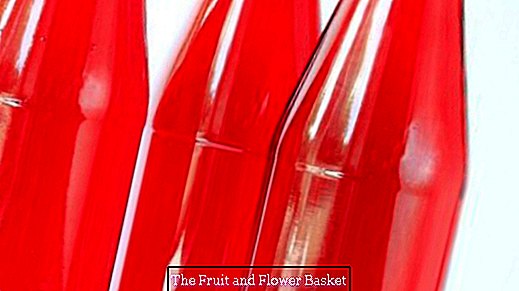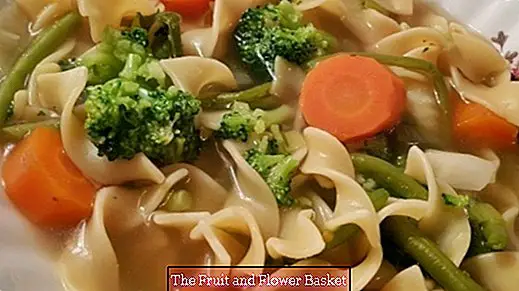Make fruit wine yourself (strawberry wine)
Fruit and fruit wines are produced by the fermentation of fruits and fruits. The production is easier than might be suspected. The most important thing is good fruit and a little patience. The wine can be made from almost all types of fruit. Not only common varieties such as cherries, strawberries or blackberries are suitable, also rhubarb, bananas or oranges can be used for wine production.
Juice fermentation and mash fermentation
Basically, one differentiates between the production of fruit and fruit wine, between a juice or a mash fermentation. We focus here on the mash fermentation, as this process is usually the more successful, or simpler and more flavorful. Mash means fruit porridge made from fruits.
A juice fermentation is done with fruits that are previously juiced; These include apples, oranges and pears or quinces. The colors and flavors, which are mainly in the shell and in the cells of the fruit, are unfortunately lost in this method.
Fruits suitable for mash fermentation:
Basically all fruits that you can crush are: bananas, strawberries, currants or blackberries. The selection is great - you choose according to taste and season. The more aromatic the fruit the more aromatic the wine should become.
Basics of the fruits and the production:
- The fruits must be very ripe, but also impeccable in quality. Do not use soggy, rotten or flavored fruits.
- Fungi and bacteria must be avoided and thorough cleaning before processing the fruits is urgently needed.
- The basis of a fruit wine are the fruits and sugar. Most types of fruit already contain part of the necessary sugar.
- From the ripe fruits, the mash (fruit porridge) is made by crushing. The seeds of the fruits should not be damaged because they can give off bitter substances.
- In order for the mash to have a sufficiently fluid consistency, it is usually necessary to add water to it.
Example for the production of fruit and fruit wine, based on a guide for strawberry wine:
equipment
- 1 fermentation container (glass balloon) with a fermentation attachment
- kitchen scale
- kitchenknife
- 1 bowl / 1 bucket
- 1 rammer to crush the fruits
- Bottles for filling
- Burlap sack, linen cloth / cotton cloth
ingredients
As a rule, the recipes for fruit and fruit wines are designed for 10 liters. That means 10 liters of wine, which gives about 5 liters of wine.
- 3.5 L of water
- 6 kg strawberries
- 2.5 kg of sugar
- 30 g of lactic acid
- 10 ml antigel
- 1 pure culture yeast culture port wine
- 1 g of potassium bisulfite
- 5 yeast nutrient salt tablets
The ingredients and accessories are available online, in some garden centers, or in individual home-based stores.
Where do you get accessories and ingredients?
The best and easiest way to get accessories and ingredients online. Often, ready-made sets are offered. There are many different providers on the net. Also, some garden centers and housewares shops offer accessories and ingredients, but mostly in a smaller selection. The offer is very different and must be found out in detail. Garden centers tend to be a bit better equipped.
tip
Strawberry wine is best prepared in early summer, when strawberry season is. Then you get the most aromatic fruits, besides, in the early summer, the temperature conditions are very favorable and the fermentation lasts only about a week. (7-10 days)
preparation
- The pure yeast is propagated a few days before the preparation of the mash in a ¼ liter of apple juice.
- Wash the strawberries well, drain and free from the green leaves and stems. (Removal is not essential for larger quantities as they do not adversely affect the fermentation process.)
- Halve strawberries and make a solution of water and sugar.
- Now crush the peas. Do not crush too much.
- Add the strawberries with the sugar-water solution, the yeast nutrient salt, the lactic acid, the potassium bisulfite and the antigel to the fermentation tank. In addition there is the prepared and increased pure breeding yeast. The fermentation tank may only be filled up to half with the brewing unit as the mash rises during the fermentation process.
- The fermentation attachment comes to the fermentation tank and is then placed in a warm place.
- After about 7? 10 days, the mash is poured into a burlap sack and squeezed out over a bucket.
- The fermentation tank must be cleaned and then the juice is filled in and sealed with the fermentation. Then the whole thing has to stand cool again for about 2 weeks (a cellar is good for it).
- After the two weeks, a sentence has formed and the wine must be deducted from it. This works like this: with a clean plastic tube, the wine is allowed to flow into a lower (fermenting) vessel. The sediment must not be whirled up and then discarded.If necessary, sweeten with a sugar-water solution a little.
- Now, the wine is stored in a clean fermentation vessel to clarify the wine in a cool place again.
- If the wine does not become clear by itself, it can be clarified by the addition of silica sol or filtered through a cloth.
Shelf life of strawberry wine
Strawberry wine should be consumed within a few months. Due to a lower alcohol content and volatile flavorings, its storage time is limited. The storage room should be as dark and cool as possible (basements are good).
The preparation of fruit and fruit wine when using other fruits may vary. Mostly the process is similar. It is best to select a recipe for the particular fruit to be used, since preparation of the mash or the standing time or fermentation time may be different.





